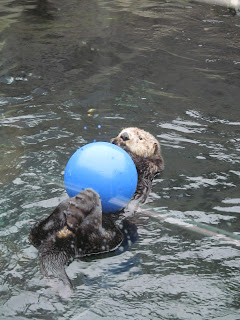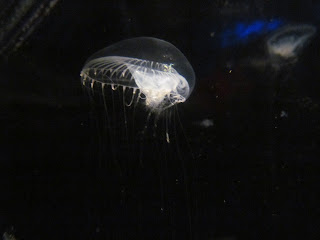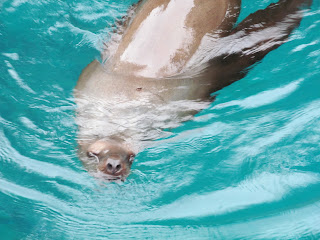AQUARIUM!
I do not know about you but I LOVE the aquarium
On a chilly fall day, my class ventured off on a field trip. We don't get many field trips in highschool so I know when we do have them, I must treasure it. An hour bus drive, a few songs to sing along to with friends, and outbursts of boys arguing over who won their "Mario Kart" battle later, we arrive at the Vancouver Aquarium.
In Biology class, we have moved on from fungi to different types of marine animals such as cnidarians. We learnt about the four phyla and what some look like. I believe the purpose of the trip was to incorporate that visual aspect. Not only did we get to see real living and breathing cnidarians, we got to further expand our knowledge about them. We also learnt how to protect these animals and got to see with our own eyes how they move. With the "Wet Lab" my class got to touch some starfish, sea cucumbers and sea urchins. My favourite was the starfish because one of them stuck to my hand which felt really neat!
On scene, we were given a scavenger hunt to fulfill by the end of the day. It had various questions that obligated us to explore the entire aquarium. The array of different animals, including monkeys, was breathtaking. I watched the Beluga show and not only did I learn about Belugas, I got to see tricks and get tips on saving the environment. Did you know Belugas live in the Arctic and the St. Lawrence River?
What we learn in Biology class is to not only test our knowledge and skill or memorizing a potpourri of terms, but also to open our eyes to the world through learning about basic organisms such as lichen, to more complex organisms like the tiger. We also learn to create awareness, a basis to teach future generations on how to sustain out earth. I believe that the aquarium hits that goal because I was moved by the knowledge I read about sustainability and how I can take part in saving our planet.
Scavenger Hunt
Can you answer them all?
 |
| Clown Fish and Anemone |
Describe the symbiotic relationship between Clown Fish and Anemone:
Clown fish have have very similar cells as an anemone; therefore, they can not be stung. The Clown Fish in exchange use the anemone as a habitat. In return, the clown fish cleans the anemone and lures in potential prey.
 |
| Sea Otter |
Why do Sea Otters spend so much time cleaning their coats?
In order to stay warm in the chilly water, sea otters constantly clean their pelt therefore trapping air acting as blubber. Only a clean fur can have this outer "skin" of air.
Before the 1900s, where could you find Sea Otters? When were they reintroduced?
Many were found in either Alaska or Amchtka Island. Because of their gorgeous pelts, they were hunted and neared extinction The sea otters were then protected and mated until their reintroduction in 1969- 1970.
 |
| I named him Beans |
What colour were the sea anemones next to the Sea Otters' tank?
The sea anemones are this beautiful bright green colour.
 |
| Beautiful ! |
 |
| I shall call him squishy. He will be my squishy. |
What is your favourite invertebrate and describe what adaptations it has for survival.
My favourite invertebrate would have to be the jellyfish. I enjoy the various looks and colours they have. The one to the right reflects light and creates a rainbow surface on their epidermis. The one below is the Japanese Sea Nettle. It is known to "sneeze" from expelling a harpoon like spear into the attacker's body.
 |
| Gorgeous |
JELLYFISH
What is the scientific name for a Belgua? How many are there in the aquarium?
The scientific name is Delphinaplerus Leucus and currently, two inhabit the tank.
 |
| Baby, beluga; oh baby beluga! |
http://www.youtube.com/watch?v=mK1sF6kv0l8
Find the potbelly seahorses. Describe how the move.
Unfortunately the potbelly seahorse tank was taken out but instead we found a different species of seahorses; however, the movement seems to be the same. They extend their tail then curl it back it. This propels their selves forward.
 |
| Seahorse |
Find and write down the name of an organism that looks like the human nervous system organ.
 The Pacfic Stinging Nettle because of all its nematocysts that look very similar to the nerves that make up the human nervous system.
The Pacfic Stinging Nettle because of all its nematocysts that look very similar to the nerves that make up the human nervous system.
Find a Starry Flounder. What two interesting adaptations does it have?
 |
This guy was a bugger to take a picture of, he kept moving!
|
This type of fish are flat thus making it easier to camouflage itself in the sand along with it's colouring. He can hide from predators and lurk for prey.
Find the Moon Jellies. Describe their movement. What adaptations do the have for feeding on plankton.
 |
| They are see through because they are mostly made up of water. |
You can say that moon jellies waft through the water by tensing and relaxing their "head". This allows plankton to be sucked into the moon jelly and digested for nourishment.
Find the Pacific Octopus. What purpose do the white suction cups on it's arms have? Why is it known as one of nature's best predators?
 |
| Octopus |
The suction cups are used for moment and to grab a hold of prey. Its considered one of nature's best predators because of its ability to hide in small places and camouflage itself.
What are the different types of feeding types in the Stellar Sea Loins?
 |
| Meet Phil the Sea Lion |
Stellar Sea Lions eat squid and fish. In order to obtain a meal, they hunt but chasing the prey in large groups.
Take a walk to the Amazon Rain Forest. Find the Caiman. Where did it come from?
 |
| Caiman, beauty! |
The Caiman is found in countries such as Brazil, Argentina, Bolivia and Paraguay.
Describe the colour of the of the crocodile. Why do you think that this is good survival strategy?
The colour appears to be green, grey and a brownish colour. This would be excellent for camouflaging itself for not only protection, but also for stalking prey.
What is the name of the largest fish in the aquarium?
 |
His name is "Tiny"
|
They call them Arapaima.
They can grow up to an astonishing 3 meters long!
Find the vegatrain fish in the Amazon flooded forest. What is it's name? What does it eat?
The Red Hook Silver Dollar. Its meal is the seeds off of riverside shrubs.
When are the piranhas the biggest threat to humans?
When we are forced to remove the hooks from the piranhas mouth. Don't want to lose a finger!
 Find the sharks. How many bones do they have?
Find the sharks. How many bones do they have?
Trick question! They have none! They have cartilage instead of bones.
Name other organisms that live in the tank with the sharks.
Green Sea Turle, Blacktip Reef Shark,
White Spotted Bamboo shark, Stringray,
Laced Moray, Common Bluestripe Snapper,
Redtail Butterfly fish, Yellowface Angelfish and the Indo-Pacific Sergeant.
Find the scientific name for the Giant Red Sea Urchin. Describe an adaptation the urchin has for survival in its aquatic environment.
 |
| Love the colour! |
The scientific name is Strongylocentrotus
Francisconus.
The adaptation is the spikes on the outer part of the urchin. This wares away predators.
How do Archerfish find their food?
Once they detect an insect, the shoot a jet blast of water and drowns them. Then the munch up their meal. Unique!
LOOK FOR YOURSELF!
Find the name of the Sea Turtle in the Tropic Zone.
 The Sea Turtle's scientific name is Cheloina Mydas.
Her given name is Schoona
The Sea Turtle's scientific name is Cheloina Mydas.
Her given name is Schoona.

Isn't she gorgeous?
HERE ARE SOME OF MY FAVOURITE PICTURES!
 |
| She came right up to us! |
 |
| Some sea anemones |
 |
| Isn't that so cool? |
 |
| What are you doing in there Shelby? |
 |
| Oh hey! |
 |
| Jelly fish, jelly fish, swimming in the waaattter! |
So we decided when we wanted to grow up, we wanted to be penguins....
 |
| Foirdland |
 |
| Snares |
 |
| Macaroni |
 |
| Little |
 |
| Chinstrap |
 |
| Adelie |









































































